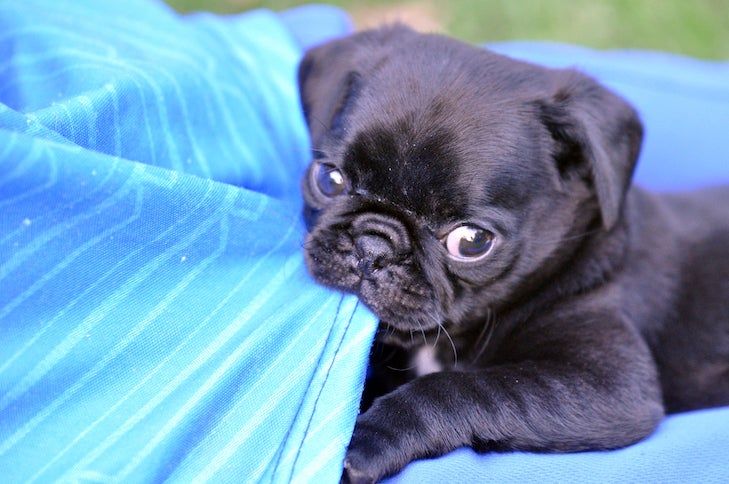Once the loyal companions of Chinese royalty, today’s Pugs live to please their owners. With their friendly, fun-loving personalities, it’s no wonder that this largest member of the Toy Group makes the ideal companion.
Prepping a Pug pup to follow good behavior guidelines isn’t tricky. Forget intense training, as a little planning and consistency will go a long way.
For key training milestones when your pup comes home, we talked to Liz Sedlak, the City of Angels Pug Club president, a 20-year AKC breeder of Belaire Pugs, and Pat Kolesar Stoltz, a past president of the Pug Dog Club of America. Stoltz has bred, raised, and trained her AKC Tupelo Champion Pugs for more than 40 years.
Growth Stage: Between 8-16 weeks
A new pup comes with new experiences. Ease the transition from the breeder to your household by setting your pup up for success.
Training goal #1: Teach Your Pug to Love Their Name
Choose a name for your little one. In a happy voice, repeat it often and immediately offer a treat or a toy. Your Pug learns those good things happen when he hears his name and comes to you.
“Pugs are highly motivated by tiny bits of treats they don’t get all the time, such as hot dogs, cheese, or leftover chicken,” says Stoltz. “A Pug pup takes to training with food like a fish to water.”
Training Goal #2: Set a Schedule
Choose regular times for meals, sleeping, bathroom breaks, and training. Don’t forget plenty of playtimes!
Training Goal #3: Crate Train and House Train Your Pug
Your Pug may arrive with some knowledge of crate and potty training, but you’ll need to reinforce these skills as soon as your pup comes home. When a dog feels comfortable inside their crate, housetraining is easier. That’s because puppies don’t like to mess where they sleep.

Training Goal #4: Introduce Grooming.
To keep your Pug in tip-top shape, begin building a positive association with grooming. To make that happen, give yummy treats and praise during sessions.
Your pup will need regular bathing, brushing, nasal and wrinkle cleaning around the face and body. Don’t forget nail trimming and dental care.
Pugs shed all the time, but a daily five-minute brushing keeps the hair in the brush rather than falling on the floor and furniture.
Between 16 and 24 weeks, 28 baby teeth will fall out, and 42 permanent teeth will erupt. Begin brushing your dog’s permanent teeth. This helps your Pug accept lifelong oral care.
Expect your puppy to chew on everything. To save your possessions, provide plenty of toys and playtime. Keep precious objects picked up from the floor and out of the pup’s reach.
Training Goal #5: Socialize Your Puppy to People, Places, and Situations
According to the breed standard, Pugs are even-tempered with an outgoing, loving disposition, “These are curious creatures who want to check everything and everyone out,” explains Sedlak.
This age is an ideal time to introduce your Pugs to other people, places, and experiences. This is a great way for young dogs to feel comfortable with the world around them. To accomplish this, invite friends and family to your home to meet your Pug and take your pup to any public place that allows dogs.
“Make sure the weather and pavement are cool, as Pugs can’t tolerate humidity and a hot temperature,” says Sedlak.
Training Goal #6: Teach Your Pug Basic Commands
“To get your Pug’s attention, teach your pup to Watch Me,” says Stoltz.
Use a clicker. When your dog looks at you, click it and give your pup a treat, she adds.
“At 16 weeks, your Pug is ready for puppy classes taught with positive reinforcement,” says Stoltz.
Your Pug is ready to follow basic cues, such as sit, down, leave it, and come.
Pug puppies are ideal candidates for The AKC S.T.A.R. Puppy program.

Puppy Stage: By 6 months
Training Goal #7: Go to Place
Want to enjoy a peaceful dinner without your Pug begging for food?
Want to greet visitors at your door without your puppy jumping on guests? If so, teach Go To Your Place.
Use a portable mat. Give your Pug a high-value treat when your Pug goes to the mat.
Training Goal #8: Walk Politely on a Leash
Imagine going for a stroll with your dog without them pulling the leash.
“Teach your Pug to walk without pulling by starting with a loose leash and walking a few steps,” says Stoltz. “Stop, click, say ‘good dog’ and give a treat.”
Growth Stage: By One Year and Beyond
Training Goal #9: Involve your Pug in AKC activities.
“Pugs are little sponges, and they will soak up learning tricks,” says Stoltz. “They love participating in Barn Hunt and Scent Work.”
Save agility and FastCAT until your Pug is at least 18 months old. Its body needs that time to fully develop, recommends Stoltz. However, there are many foundational, low-impact agility classes that dogs can participate in prior to 18 months.
“This breed makes a perfect companion for children learning to read,” says Stoltz. “Pugs will sit for hours and listen to story after story.”
A busy Pug is a happy Pug. Keep yours physically and mentally active.

